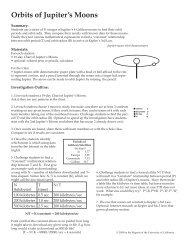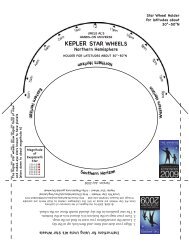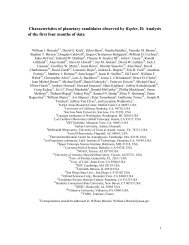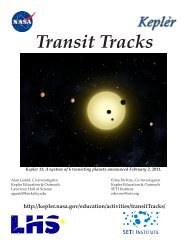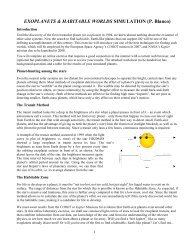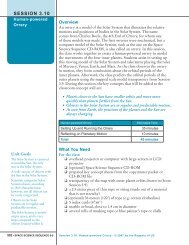Poster Abstracts - Kepler - NASA
Poster Abstracts - Kepler - NASA
Poster Abstracts - Kepler - NASA
- No tags were found...
Create successful ePaper yourself
Turn your PDF publications into a flip-book with our unique Google optimized e-Paper software.
POSTER ABSTRACTSP0506. POSTER SESSION IREFRACTION OF LIGHT IN EXOPLANET ATMOSPHERES.Taishi Nakamoto 1 and Tetsuo Yamamoto 2 , 1 Tokyo Institute of Technology (Meguro, Tokyo 152-8551, Japan,nakamoto@geo.titech.ac.jp), 2 Hokkaido University (ty@lowtem.hokudai.ac.jp).Introduction: Some exoplanet atmospheres havebeen observed by transit photometry and spectroscopy.Their composition, temperature, and stratified structurehave been investigated based on those observations[e.g., 1 and references therein]. In the analyses, pathsof light that is emitted from the central star and passesthrough the atmosphere are assumed to be straight [2].In general, however, the path of light in the atmospherewould be curved due to the refraction by the atmosphere.In addition, the refraction is generally dependenton the wavelength of light. Thus, the color dependentrefraction may affect the observed quantities. If it isthe case, we would be able to obtain some informationabout the exoplanet atmosphere by observing the refraction.The refraction of light by exoplanet atmospherwas studied by [3]. In this study, we derive ahigher order analytic formula for the refraction angle,and examine the effect of refraction.Refraction Angle: We derive an analytic formulafor the refraction angle. We assume that the planetincluding the atmosphere is spherically symmetric, theatmosphere is isothermal, and the atmosphere is in thehydrostatic equilibrium. The refraction angle Θ is thengiven as,!(b,!) " 2"bH #(b)exp %$ b $ R ( +'& H )* 1+ %'3 & 2 $S (0 * b#(b)) H$ H .-0,,8b/where b is the impact parameter, ω is the frequency ofthe light, H is the scale height of the atmosphere, R isthe radius of the solid part of the planet, S 0 = 0.0858 isa constant, and Δ(b) is given by,!(b) = n2 (R)"1 #exp " b " R &% (,2 $ H 'where n(R) is the refractive index of the atmosphericgas at the bottom of the atmosphere. This formula is ahigher order one than that given by [3].Figures 1 and 2 show paths of light in the atmosphereand the refraction angle of the light obtained bynumerical calculations and the analytic formula. Inthese calculations, an Earth-like model planet is used:the radius of the solid part of the model planet and thecomposition of its atmosphere are equal to those of thecurrent Earth, and the temperature is 290K. We can seethat the light passing through the planetary atmospherecan be refracted.Figure 2: Refraction angle as a function of impactparameter.References: [1] Seager S. and Drake D. (2010)ARA&A, 48, 631–672. [2] Brown T. M. (2001) ApJ,553, 1006–1026. [3] Sidis O. and Sari R. (2010) ApJ,720, 904–911.Figure 1: Paths of light passing through the atmosphere.Green and red curves correspond to the lightwith wavelengths of 500 µm and 800 µm, respectively.Light blue curves show height from the solid surface inunit of the atmospheric scale height.2011 <strong>Kepler</strong> Science Conference - <strong>NASA</strong> Ames Research Center 171



